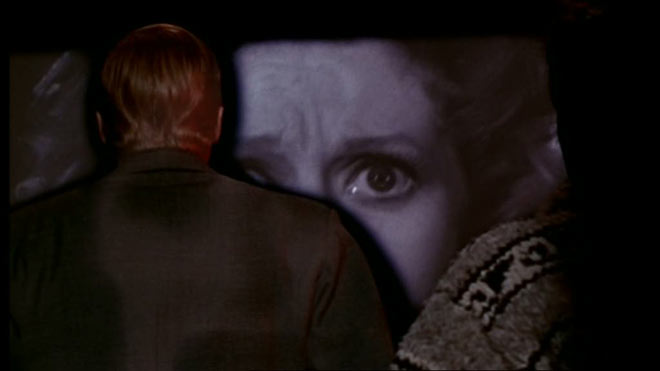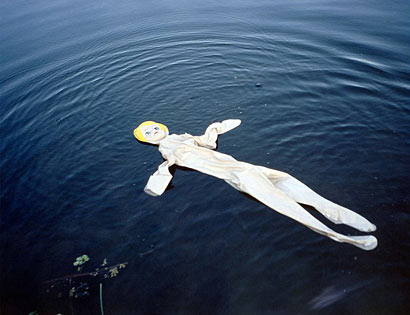Ellsworth Kelly |
May 23rd, 2012

A computational model is a surrogate version of something usually made on a computer. An example that most people are familiar with are the computational models used to predict the weather. If you know how low pressure and high pressure fronts interact, and you know where one is and how fast it is moving, you can program software to play the situation out in a simulation, predicting what will happen and how quickly. […]
If you know how the thalamus, hippocampus, amygdala, and cortex all work together, you can simulate how inputs into one structure might influence the others. In this case each brain structure would basically be a ‘black box’ that received input and produced output based on known data.
{ The Cellular Scale | Continue reading }
brain, neurosciences |
May 23rd, 2012

I myself spent nine years in an insane asylum and I never had the obsession of suicide, but I know that each conversation with a psychiatrist, every morning at the time of his visit, made me want to hang myself, realizing that I would not be able to cut his throat.
{ Antonin Artaud, Van Gogh: The Man Suicided by Society, 1947 }
No one personifies the thorny entanglement between modernism and the science of the soul better than Dr. Gaston Ferdière, the psychiatrist who administered no less than 58 electroshock treatments to the Surrealist playwright Antonin Artaud during the Second World War. Determined to reconcile poetry and medicine, Ferdière had studied under “Professor Claude”— target of Breton’s anti-psychiatric rants—at Sainte-Anne while at the same time passing as a “star of Surrealism in the bistros” of Paris in the mid-1930s. A friend of Breton, Desnos, Péret, and Crevel, the young Dr. Ferdière arranged to have a mural painted in the Sainte-Anne guardhouse by an artist close to the movement, and he even published several volumes of poetry himself.
By the time Artaud showed up on his doorstep at Rodez psychiatric hospital, Ferdiére had long since abandoned his poetic aspirations. Yet his old interests were rekindled in long conversations with the Surrealist playwright, whose talents he sought to revive by a combination of “art therapy”—writing, drawing, translating Lewis Carroll’s Through the Looking Glass—and shock treatments—six courses ranging from 4 to 13 sessions each between June 20th, 1943 and January 24th, 1945. Electroshock was still in its experimental phase—the machine had hardly rolled in the door at Rodez—and the convulsions were so severe that Artaud fractured a vertebra in his neck during one of the treatments.
The strange case of Ferdière and Artaud remains a source of controversy to this day. On the one hand, there can be little doubt that the psychiatrist saved Artaud’s life by taking him in. The playwright had been confined to various mental hospitals since suffering a psychotic break in 1936, but with the outbreak of war the Nazis restricted food supplies to asylum patients, and by 1943 Artaud was on the brink of starvation. Spirited out of Occupied France to the “free zone,” he quickly recovered under the care of Dr. Ferdière, who openly defied the restrictions and kept his patients well fed by working the black market.
{ Yale University, | PDF | Antonin Artaud (1896 – 1948) was a French playwright, poet, actor and theatre director. | Wikipedia }
artwork { Robert Motherwell, Africa Suite, Africa 6, 1970 }
flashback, ideas, poetry, psychology |
May 23rd, 2012

Do facts exist? At least one person has claimed that facts do not exist and that thinking they exist would violate Occam’s razor [a simpler explanation is better than a more complex one]. However, there is much to be said as to why we have reason to believe that facts exist, such as the reasons to endorse various kinds of realism. I will discuss what facts are, whether they are supposed to refer to something that exists, whether any facts exist, and an objection against their existence. I will argue that all objections to the existence of facts are self-defeating and we have more reason to believe that some facts exist than that no facts exist as a result.
{ Ethical Realism | Continue reading }
painting { Picasso, La Celestina, 1904 }
ideas |
May 23rd, 2012

The self-punishment we learn as children may continue into adulthood, when we become, in effect, parents to ourselves. Although some adults are more prone to self-flagellation than others, this tendency appears to be common even among psychologically healthy individuals. Research conducted in the field of social psychology suggests at least three major reasons why people might, at times, choose to punish themselves.
{ Psych Your Mind | Continue reading }
photos { James Friedman }
psychology |
May 23rd, 2012

If you are an IPO company founder and — even more explicitly — you are Facebook CEO Mark Zuckerberg, you want your share price on the first day to go exactly nowhere, which is what Facebook did. That means no money was left on the table and the company got the best possible deal.
Zuckerberg didn’t and doesn’t care about investors in this scenario. He just doesn’t give a damn. Investment bankers do give a damn because they’d like to have another IPO next week or next month and have that go very well, too. Zuckerberg expects Facebook to never issue another share of stock. He’s done raising money thanks, and on his honeymoon.
I’m sure there was a struggle at the end over how to price the offering. The bankers would have preferred $34 or even $32, but Facebook went for $38 and they were correct to do so from their point of view because we now see it was the optimal solution.
{ Cringely | Continue reading }
As Facebook shares continued their slide, regulators launched inquiries into whether privileged Wall Street insiders were alerted to the company’s weakening financial projections, leading them to shun the stock or dump shares just as buying was opened to the public. […]
SEC Chairwoman Mary Schapiro said the agency will examine “issues” into the bungled Facebook public offering. […]
The legal issue raised could be “securities fraud — plain and simple,” said Ernest Badway, a securities lawyer in New York and New Jersey and a former enforcement attorney at the U.S. Securities and Exchange Commission.
{ LA Times | Continue reading }
One mutual fund source said they had never, in a decade of experience, seen an underwriter cut a company’s outlook during the road show prior to an offering. […]
Brokers who over-ordered shares in the expectation that supply would be limited continued to complain they received too much stock to handle and were left in the dark about forecast changes.
{ The Age | Continue reading }
photo { Victor Cobo }
economics, shit talkers |
May 23rd, 2012

The last time I saw paintings as deluded as Damien Hirst’s latest works, the artist’s name was Saif al-Islam Gaddafi. A decade ago the son of Libya’s then still very much alive dictator showed sentimental paintings of desert scenes in an exhibition sponsored by fawning business allies. Searching for some kind of parallel to the arrogance and stupidity of Hirst’s still life paintings, I find myself remembering that strange, sad spectacle.
There is a pathos about Two Weeks One Summer, in which Hirst shows paintings of parrots and lemons, shark’s jaws and foetuses in jars in a vast space in White Cube Bermondsey. It is the same kind of pathos that clings to dictators’ art. This is the kind of kitsch that is foisted on helpless peoples by Neros and Hitlers and such tyrants so beyond normal restraint or criticism they believe they are artists.
{ Jonathan Jones/Guardian | Continue reading }
photo { James Friedman }
art, haha |
May 23rd, 2012

Great ideas come when you aren’t trying. […]
A study suggests that simply taking a break does not bring on inspiration — rather, creativity is fostered by tasks that allow the mind to wander.
{ Nature | Continue reading }
ideas, psychology |
May 22nd, 2012

Journalists develop new units of measure to explain complex and elusive concepts. The unit he shared, which he credits to Salopek, is the Jolie. A Jolie is a unit that denotes the amount of international aid a country receives when it becomes the cause celebre of a prominent celebrity. He offers a working definition as the difference between aid per person to Darfur, which benefits from Jolie’s focus and advocacy, and the Democratic Republic of Congo, which has not.
Jolie is able to attract aid to Darfur through her passion, her hard work, but ultimately through the fact that she’s the subject of a great deal of attention. While her recent films may not have attracted as much attention as her work as Lara Croft, she commands approximately 35 centiKardashians of attention.
The Kardashian is a unit I proposed a few classes back as a measure of attention. Conceptually, the Kardashian is the amount of global attention Kim Kardashian commands across all media over the space of a day.
{ Ethan Zuckerman | Continue reading }
photo { Angelina Jolie by David LaChapelle }
celebs |
May 22nd, 2012

Millennium Challenge 2002 (MC02) was a major war game exercise conducted by the United States armed forces in mid-2002, likely the largest such exercise in history. The exercise cost $250 million, involved both live exercises and computer simulations.
MC02 was meant to be a test of future military “transformation”—a transition toward new technologies that enable network-centric warfare and provide more powerful weaponry and tactics.
Red, commanded by retired Marine Corps Lt. General Paul K. Van Riper, used old methods to evade Blue’s sophisticated electronic surveillance network. Van Riper used motorcycle messengers to transmit orders to front-line troops and World War II light signals to launch airplanes without radio communications. … In a preemptive strike, Red launched a massive salvo of cruise missiles that overwhelmed the Blue forces’ electronic sensors and destroyed sixteen warships. […]
Another significant portion of Blue’s navy was “sunk” by an armada of small Red boats, which carried out both conventional and suicide attacks that capitalized on Blue’s inability to detect them as well as expected.
At this point, the exercise was suspended, Blue’s ships were “re-floated”, and the rules of engagement were changed. … The war game was forced to follow a script drafted to ensure a Blue Force victory. […] Red Force was ordered to turn on all his anti-aircraft radar in order for them to be destroyed, and Red Force was not allowed to shoot down any of the aircraft bringing Blue Force troops ashore. … They also ordered Red Force not to use certain weapons systems against Blue Force and even ordered that the location of Red Force units to be revealed. […]
Due to his criticism regarding the scripted nature of the new exercise, Van Riper resigned his position in the midst of the war game.
War colleges, where people learn to be soldiers, often have war simulations where different people play different parts of a war between “us” and “them.” Students and others are told that these are realistic, or at least as realistic as is feasible given the simplifications that simulations and games require.
But I’ve now heard personally from enough independent expert insider sources that I’m willing to post it: the above example was not a rare exception; war games are mostly fake.
{ OvercomingBias | Continue reading }
fights, ideas |
May 22nd, 2012

The 50-year-old [David Harding] runs Winton Capital, one of a secretive but influential band of computer-driven hedge funds that bet tens of billions of dollars on the world’s financial markets using algorithms - mathematical instructions to computers - which consume everything from bond price moves to rainfall statistics.
For Harding, whose business attracts mainstream pension investors from the world over, all of human knowledge is relevant. Rivals are circling, and data is becoming an increasingly strategic weapon.
Winton’s collection of funds is now worth more than $29 billion. It has returned 14.8 percent a year in its main fund over the past decade - one of the best records over that period in the UK - and Harding is now likely to be Britain’s highest-paid person, according to this year’s Sunday Times Rich List. It says his wealth almost doubled last year to 800 million pounds ($1.27 billion).
Funds like his are known in the industry as trend-followers, managed futures funds or Commodity Trading Advisors (CTAs). Now run almost entirely by scientists, their ‘black box’ trading has entered popular culture: Robert Harris’s latest thriller, “The Fear Index”, features a fictional physics expert like Harding and rogue computer code.
But as algorithmic hedge funds have become better known and sucked in investors’ money, returns have started to falter. Managed futures funds on average have lost money in two of the past three years, gaining just 4 percent in aggregate while the S&P 500 rose 49 percent.
The funds are struggling to cope with skittish markets. But they’re also being squeezed by a more mundane fact: their basic techniques aren’t so hard to copy, and can be worked out with a few internet searches.
{ Reuters | Continue reading }
economics, traders |
May 22nd, 2012

There are several trends that might suggest a diminishing role for mathematics in engineering work. First, there is the rise of software engineering as a separate discipline. It just doesn’t take as much math to write an operating system as it does to design a printed circuit board. Programming is rigidly structured and, at the same time, an evolving art form—neither of which is especially amenable to mathematical analysis.
{ IEEE | Continue reading }
photo { Guillaume Zuili }
ideas, mathematics |
May 22nd, 2012

Human use of water contributes markedly to rising tides.
During the latter half of the twentieth century, global sea level rose by about 1.8 millimetres per year, according to data from tide gauges.
The combined contribution from heating of the oceans, which makes the water expand, along with melting of ice caps and glaciers, is estimated to be 1.1 millimetres per year, which leaves some 0.7 millimetres per year unaccounted for. This gap has been considered an important missing piece of the puzzle in estimates for past and current sea-level changes and for projections of future rises.
It now seems that the effects of human water use on land could fill that gap.
A team of researchers reports in Nature Geoscience that land-based water storage could account for 0.77 millimetres per year, or 42%, of the observed sea-level rise between 1961 and 2003. Of that amount, the extraction of groundwater for irrigation and home and industrial use, with subsequent run-off to rivers and eventually to the oceans, represents the bulk of the contribution.
{ Nature | Continue reading }
photo { Joel Barhamand }
science, water |
May 22nd, 2012

Just a couple of weeks ago, we discussed a Chinese experiment in which physicists teleported photons over a distance of almost 100 kilometres. That’s almost an order of magnitude more than previous records.
Today, European physicists say they’ve broken the record again, this time by teleporting photons between the two Canary Islands of La Palma and Tenerife off the Atlantic coast of north Africa, a distance of almost 150 kilometres.
{ The Physics arXiv Blog | Continue reading }
science, technology |
May 22nd, 2012

By 2025, when most of today’s psychology undergraduates will be in their mid-30s, more than 5 billion people on our planet will be using ultra-broadband, sensor-rich smartphones far beyond the abilities of today’s iPhones, Androids, and Blackberries.
Although smartphones were not designed for psychological research, they can collect vast amounts of ecologically valid data, easily and quickly, from large global samples. If participants download the right “psych apps,” smartphones can record where they are, what they are doing, and what they can see and hear and can run interactive surveys, tests, and experiments through touch screens and wireless connections to nearby screens, headsets, biosensors, and other peripherals.
This article reviews previous behavioral research using mobile electronic devices, outlines what smartphones can do now and will be able to do in the near future, explains how a smartphone study could work practically given current technology (e.g., in studying ovulatory cycle effects on women’s sexuality), discusses some limitations and challenges of smartphone research, and compares smartphones to other research methods.
{ SAGE | PDF }
photo { Tamir Sher }
psychology, technology |
May 21st, 2012

Human beings are motivated to form and maintain interpersonal relationships. In this context, self-presentation and self-disclosure have been described as strategies to initiate the formation of relationships: Especially in early stages, people have to attract the attention of others by means of self-presentational behavior. Therefore, presenting him- or herself in a positive and elaborated way can be seen as one way to establish new contacts and thereby satisfy the so-called need to belong. The term “impression management” aptly describes this strategy “to convey an impression to others which it is in his interests to convey.” In real-life situations, these impression management behaviors consist of intentional verbal communication (speech, written texts) as well as of possibly unintentional nonverbal expressions.
Nowadays, with the help of social networking sites (SNS) on the Internet such as Facebook, further possibilities are given to present oneself to others: Users can, for instance, upload photographs, join groups, and provide personal information. Thus, each profile owner can make use of these specific features by selecting information which presents him/her in a positive and attractive manner. This online impression management can therefore also be useful to attract potential partners. According to previous studies on Web 2.0, self-presentation is one of the major motives for using these websites, besides communicating with friends and finding new contacts. […]
An analysis of 100 online profiles showed that singles disclosed more photographs of themselves on their profiles than people in relationships. The highest numbers of friends and wall postings were shown by people who did not reveal their relationship status. Singles displayed more groups on their profile and were more likely to join user groups dealing with parties, sexual statements as well as fun and nonsense.
{ Cyberpsychology | Continue reading }
psychology, relationships, social networks |
May 21st, 2012

Multiple Maniacs is a 1970 comedy film by American filmmaker John Waters. […]
Plot:
Lady Divine is the owner and operator of a show called The Cavalcade of Perversion, a free exhibit of various perversions and fetish acts and obscenities such as the “Puke Eater.” The show is free, although the various performers must persuade and even physically drag reluctant passers-by to attend.
As a finale to every show, Lady Divine comes in and robs the patrons at gunpoint. This arrangement seems successful to Lady Divine’s lover, Mr. David, until Lady Divine becomes bored with the routine, and decides to murder the patrons rather than merely robbing them.
{ Wikipedia | Continue reading }
ideas, showbiz |
May 21st, 2012

{ Who do we have here? This is Eddie. We’re just cruising. He’s a dude magnet. My office is on Wall Street, and if I’m with Eddie, guys just surround me. They say, “Oh my God, I used to have one of these when I was living in the country!” Or whatever. I doubt that short dress hurts. I don’t know. No one talks to me unless I’m with the dog. | NY mag | Continue reading }
experience, new york |
May 21st, 2012






















